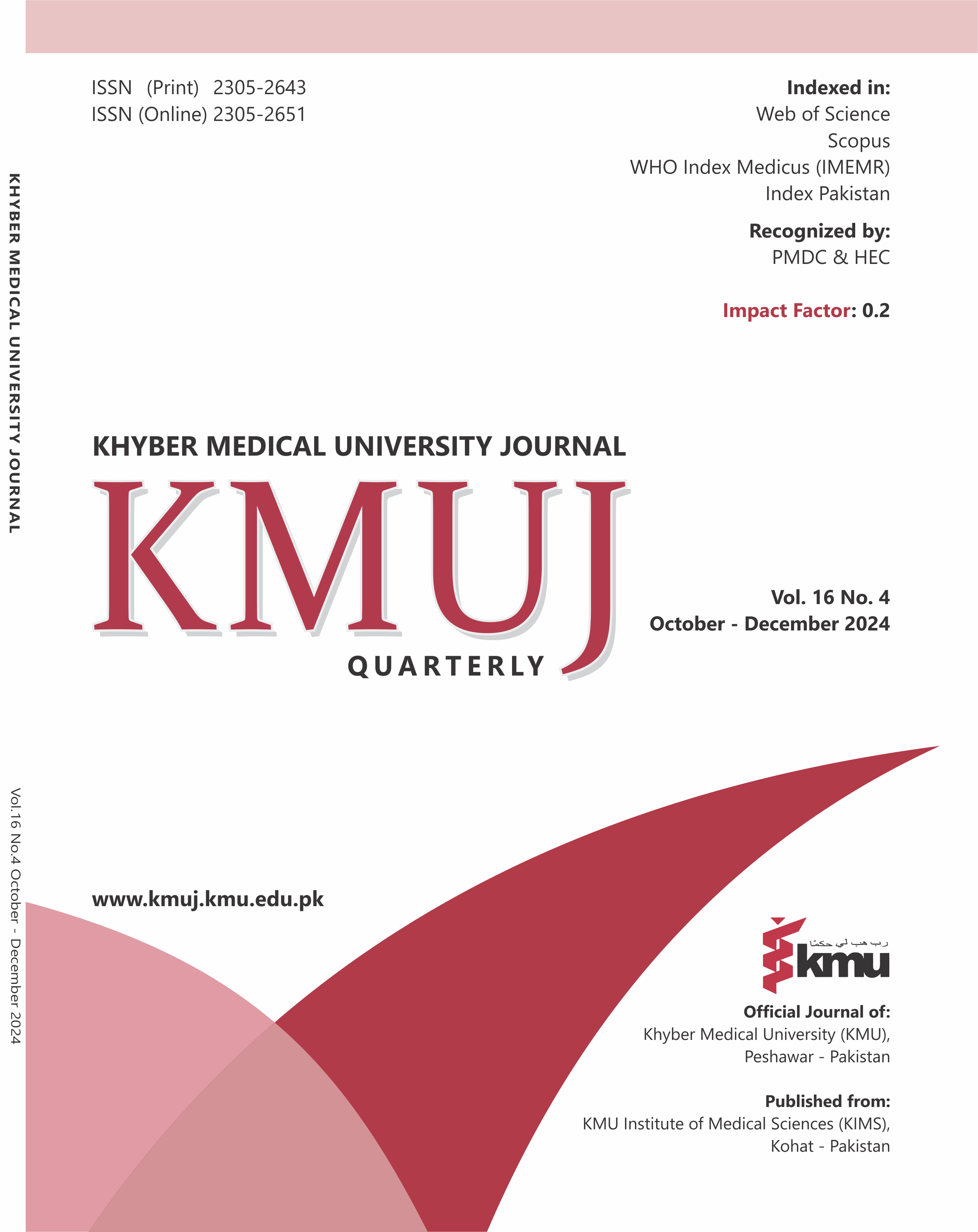Comparative effects of kinesiotaping with and without combined chain exercises on pain, range of motion, and quality of life in knee osteoarthritis: a randomized controlled trial
Main Article Content
Abstract
Objectives: To compare the effects of Kinesio Taping (KT) with and without Combined Chain Exercises (CCEs) on pain, range of motion (ROM), and quality of life in patients with knee osteoarthritis (OA).
Methods: This randomized control trial was conducted at Riphah Rehabilitation Center and Ittefaq Hospital, Lahore, over six months. Thirty-eight patients with Grade II knee OA (Kellgren and Lawrence classification) aged 40–60 years were recruited using a convenience sampling technique and allocated into two groups via the lottery method. Group A received KT with CCEs, while Group B received KT only. Pain, ROM, and quality of life were assessed using the Numeric Pain Rating Scale (NPRS), goniometer, and SF-36, respectively, at baseline and after 4 weeks. Baseline treatment included hot packs and ultrasound. Statistical analyses were performed using paired and independent t-tests.
Results: Data from 34 participants (17 per group) were analyzed. Group A (KT with CCEs) showed statistically significant improvements compared to Group B (KT only) across all parameters: NPRS (p = 0.017), knee flexion (p = 0.035), knee extension (p = 0.004), and SF-36 (p = 0.002). Within-group comparisons also revealed significant improvements in Group A across all outcomes (p < 0.001).
Conclusion: Kinesio Taping combined with Chain Exercises significantly improved pain, ROM, and quality of life in knee OA patients compared to Kinesio Taping alone. These findings suggest that integrating CCEs with KT may provide more effective rehabilitation for knee OA.
Article Details

This work is licensed under a Creative Commons Attribution 4.0 International License.
Work published in KMUJ is licensed under a
Creative Commons Attribution 4.0 License
Authors are permitted and encouraged to post their work online (e.g., in institutional repositories or on their website) prior to and during the submission process, as it can lead to productive exchanges, as well as earlier and greater citation of published work.
(e.g., in institutional repositories or on their website) prior to and during the submission process, as it can lead to productive exchanges, as well as earlier and greater citation of published work.
References
1. Lespasio MJ, Piuzzi NS, Husni ME, Muschler GF, Guarino A, Mont MA. Knee osteoarthritis: a primer. Perm J 2017;21:16-183. https://doi.org/10.7812/TPP/16-183
2. Badshah Y, Shabbir M, Hayat H, Fatima Z, Burki A, Khan S, et al. Genetic markers of osteoarthritis: early diagnosis in susceptible Pakistani population. J Orthop Surg Res 2021;16(1):124. https://doi.org/10.1186/s13018-021-02230-x
3. Danazumi MS, Ibrahim SU, Yakasai AM, Dermody G, Bello B, Kaka B. A comparison between the effect of combined chain exercises plus kinesio taping with combined chain exercises alone in knee osteoarthritis: a randomized clinical trial. Am J Phys Med Rehab 2021;100(11):1070-7. https://doi.org/10.1097/PHM.0000000000001705
4. Nahayatbin M, Ghasemi M, Rahimi A, Khademi-Kalantari K, Naimi SS, Tabatabaee SM, et al. The effects of routine physiotherapy alone and in combination with either tai chi or closed kinetic chain exercises on knee osteoarthritis: a comparative clinical trial study. Iran Red Crescent Med J 2018;20(4):1-8. https://doi.org/10.5812/ircmj.62600
5. Nayanti AP, Prabowo T, Sari DM. The effects of kinesio taping and quadriceps muscle strengthening exercise on quadriceps muscle strength and functional status in knee osteoarthritis. J Med Health 2020;2(5):40-50. https://doi.org/10.28932/jmh.v2i5.1555
6. Ye W, Jia C, Jiang J, Liang Q, He C. Effectiveness of elastic taping in patients with knee osteoarthritis: a systematic review and meta-analysis. Am J Phys Med Rehabil 2020;99(6):495-503. https://doi.org/10.1097/PHM.0000000000001361
7. Alburquerque-García A, Rodrigues-de-Souza DP, Fernández-de-las-Peñas C, Alburquerque-Sendín F. Association between muscle trigger points, ongoing pain, function, and sleep quality in elderly women with bilateral painful knee osteoarthritis. Journal of Manipulative and Physiological Therapeutics. 2015;38(4):262-8. https://doi.org/10.1016/j.jmpt.2014.10.018
8. Olagbegi OM, Adegoke BOA, Odole AC. Effectiveness of combined chain exercises on pain and function in patients with knee osteoarthritis. Bangladesh J Med Sci 2016;15(2):178-88. https://doi.org/10.3329/bjms.v15i2.24808
9. Koch M, Sarma PC, Dutta A, Kalita A. Effectiveness of combined kinetic chain exercises in the treatment of knee osteoarthritis in peri-menopausal and post-menopausal women in Guwahati, Assam, India. Int J Pharm Bio Sci 2022;12(1):38-46. https://doi.org/10.22376/ijpbs/lpr.2021.12.1.L38-46
10. Melese H, Alamer A, Temesgen MH, Nigussie F. Effectiveness of kinesio taping on the management of knee osteoarthritis: a systematic review of randomized controlled trials. J Pain Res 2020;13:1267. http://doi.org/10.2147/JPR.S249567
11. Donec V, Kubilius R. The effectiveness of Kinesio Taping® for pain management in knee osteoarthritis: a randomized, double-blind, controlled clinical trial. Ther Adv Musculoskelet Dis 2019;11:1759720X19869135. https://doi.org/10.1177/1759720X19869135
12. Taheri P, Vahdatpour B, Asl MM, Ramezanian H. Effects of taping on pain and functional outcome of patients with knee osteoarthritis: a pilot randomized single-blind clinical trial. Adv Biomed Res 2017;6:39. https://doi.org/10.4103/2277-9175.218031
13. Olagbegi OM, Adegoke BOA, Odole ACJBJoMS. Effectiveness of combined chain exercises on pain and function in patients with knee osteoarthritis. 2016;15(2):178-88. https://doi.org/10.3329/bjms.v15i2.24808
14. Langendoen J, Fleishman C, Kim SH, An HJ. Rationales and evidence of elastic taping: a clinician's perspective. J Int Acad Phys Ther Res 2016;7(1):979-88. http://dx.doi.org/10.20540/JIAPTR.2016.7.1.979
15. Castrogiovanni P, Di Giunta A, Guglielmino C, Roggio F, Romeo D, Fidone F, et al. The effects of exercise and kinesio tape on physical limitations in patients with knee osteoarthritis. J Funct Morphol Kinesiol 2016;1(4):355-68. https://doi.org/10.3390/jfmk1040355
16. Pamuk U, Yucesoy CA. MRI analyses show that kinesio taping affects much more than just the targeted superficial tissues and causes heterogeneous deformations within the whole limb. J Biomech 2015;48(16):4262-70. https://doi.org/10.1016/j.jbiomech.2015.10.036
